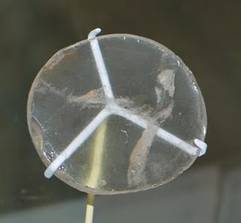The First Magnifiers
Ancient Lenses: (Optical Lenses)
The Nimrud lens: Whatever its origin, as ornament, as magnifying lens or part of a telescope, the Nimrud lens is the oldest lens in the world. Looking at it evokes mystery and wonder. It can be seen in room 55 of the British Museum, in case 9 of the Lower Mesopotamian Gallery. However unusual this object seems at first, it is not unique. In fact there are several hundred reported lenses now on record from around the ancient world.
To date, the earliest lenses identified in context are from the IV/V Dynasties of Egypt, dating back to about 4,500 years ago (e.g., the superb `Le Scribe Accroupi’ and `the Kai’ in the Louvre; added fine examples are located in the Cairo Museum). Latter examples have been found in Knossos (Minoan [Herakleion Museum]; ca. 3,500 years ago)(6)
It may not be unique. Another, possibly 5th century BC, lens was found in a sacred cave on Mount Ida on Crete. It was more powerful and of far better quality than the Nimrud lens.
Also, Roman writers Pliny and Seneca refer to a lens used by an engraver in Pompeii. So perhaps the ancients knew more about lenses than we give them credit for.
| Ancient Optical Lenses: |
Quote from Robert Temple ‘Forbidden Technology’, 2009:
‘I have found in museums all over the world, more than 450 ancient optical artefacts, most of them lenses, but in any case, magnifying aids.
These ancient lenses generally magnify about 1.5 or 2 times. Heinrich Schliemann (left), the 19th century discoverer of Troy, excavated 48 rock crystal lenses at Troy. This is one of the largest hoards of ancient lenses ever found. These were unfortunately lost for many decades because they were with the missing Trojan gold hoard which disappeared from the Berlin Museum at the end of the Second World War. In recent years the Russians have admitted that the Red Army stole the gold and it is all in Moscow today. The 48 lenses are with these gold artefacts.
Another large number of crystal lenses exist in Crete, mostly found at Knossos. And yet another hoard exists at Ephesus, in Turkey, though those ones are very unusual because they are concave lenses used to correct for myopia (short-sightedness), some shrinking images by as much as 75%.
Most ancient lenses are convex and were used to magnify. At Carthage there are 14 glass lenses and two of rock crystal stored in a drawer in the museum; they have apparently never been displayed.
Egypt too has examples one pair of glass lenses was excavated from the wrappings of a mummy and obviously were used as spectacles except that loops around the ears for modern style spectacles seem not to have been invented in ancient times. So these may have had some kind of nose loop or may have been held as a lorgnette.
The oldest evidence of a sophisticated optical capability which I have found goes back as far as 3300 BC. An ivory knife handle was excavated in the 1990s from a pre-dynastic grave of that date at Abydos in Egypt. It belonged to a king. It bears microscopic carvings which could only have been made with, and can only be seen with, a magnifying glass’

